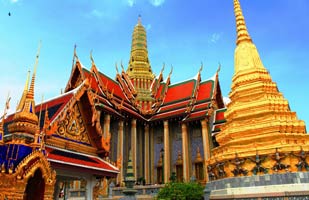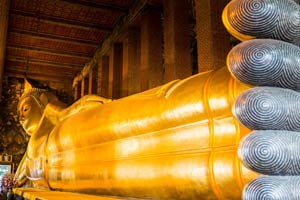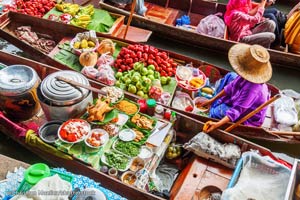 A must-see is the Grand Palace. Built in 1782 by King Rama I, this is the former royal residence of the kings of Thailand, with the last one to reside there was King Vijaralongkorn (Rama X) in 1925. Today the Palace is still used for royal ceremonies, such as coronations, state functions and welcoming the king’s guests and other foreign dignitaries. The Grand Palace consists of two main zones – the Temple of the Emerald Buddha and the Royal Residence. The Royal Residence is divided into three areas – The Outer court - where several state offices are situated today, Middle court - where the important royal ceremonies, such as the Royal Ceremony of Coronation are held, and the Inner court – where the queens, consorts, consort mothers, daughters and sons, before they reach puberty lived along with their ladies-in-waiting and servants. This was an area with extraordinary security and an area that was exclusively female-only and only the king could enter. Today no one resides there, but it’s completely closed to the public.
A must-see is the Grand Palace. Built in 1782 by King Rama I, this is the former royal residence of the kings of Thailand, with the last one to reside there was King Vijaralongkorn (Rama X) in 1925. Today the Palace is still used for royal ceremonies, such as coronations, state functions and welcoming the king’s guests and other foreign dignitaries. The Grand Palace consists of two main zones – the Temple of the Emerald Buddha and the Royal Residence. The Royal Residence is divided into three areas – The Outer court - where several state offices are situated today, Middle court - where the important royal ceremonies, such as the Royal Ceremony of Coronation are held, and the Inner court – where the queens, consorts, consort mothers, daughters and sons, before they reach puberty lived along with their ladies-in-waiting and servants. This was an area with extraordinary security and an area that was exclusively female-only and only the king could enter. Today no one resides there, but it’s completely closed to the public.
The Temple of the Emerald Buddha is another sacred site in Bangkok, and one of the three most famous temples in the City of Angels. It’s a home to a small Buddha statue, carved from a signal block of green jade in India. The word “emerald” refers to the vivid green colour of the statue, rather than its material. The statue is more than 2000 years old and has been brought to the temple in Bangkok in 1784. The 66cm tall Buddha has three sets of seasonal attires – summer, winter, and rainy season attire that HM the King changes himself in a ceremony, performed in the 1st Waning of lunar months 4th, 8th and 12th (usually March, August and November).
Remember to dress modestly when you visit the Grand Palace, no shoulders, knees and transparent clothing. Also, there is a lot of walking in the heat with hardly any shade, so the best time to visit would be early morning and make sure you have drinking water with you.
 The Temple of the Reclining Buddha (Wat Pho) is another one of the six temples in Thailand, classed with the highest grades of first-class royal temples. It’s mostly popular with the impressive, 150 feet statue of Buddha, reclining on one side, covered in gold leaf. The Temple is one of the largest and oldest in Thailand, considered the birth place of the traditional Thai massage, hosting a school of Thai medicine, and a former home to the first public university of Thailand, specialising in religion, science and literature. It’s also a home of more than 1000 images of Buddha, collected and brought from various parts of the country, as well as the neighbour countries.
The Temple of the Reclining Buddha (Wat Pho) is another one of the six temples in Thailand, classed with the highest grades of first-class royal temples. It’s mostly popular with the impressive, 150 feet statue of Buddha, reclining on one side, covered in gold leaf. The Temple is one of the largest and oldest in Thailand, considered the birth place of the traditional Thai massage, hosting a school of Thai medicine, and a former home to the first public university of Thailand, specialising in religion, science and literature. It’s also a home of more than 1000 images of Buddha, collected and brought from various parts of the country, as well as the neighbour countries.
To get a closer insight into the history, art and culture of Thailand, go and see the Bangkok National Museum. Originally opened by King Rama V to exhibit the various antiques, gifts and regalia, inherited and gifted by his father, King Rama IV, today it displays Thai artefacts dating back to Dvaravati, Srivijaya, Sukhothai and Ayutthaya periods, as well as a rich collection of regional Asian Buddhist Arts from India, China, Vietnam, Indonesia and Cambodia. The museum currently hosts three permanent exhibitions – the Thai History Gallery, the Archaeological and Art History Collection and the Decorative Arts and Ethnological Collection.
 For the ultimate shopping experience at a street market, and if you happen to be in Bangkok on the weekend, we recommend going to Chatuchak market – believed to be the largest in the world! Here you will find pretty much everything your heart desires, but mainly local handcrafts, such as wood carvings, paintings, ceramics, jewellery as well as silk and cotton fashion, antiques, souvenirs, traditional and modern crockery, household items and furniture, live plants and pets. Although the prices are normally aimed to attract locals, as well as tourists, don’t forget to bargain, especially if you are buying more than one of the same items. You would also be offered international shipping at acceptable prices, if you have run out of suitcase space. There are also various food stalls, selling everything from qual eggs to fresh coconuts to drink to make sure you stay hydrated and have energy to walk the 27 acres of 15000 booths of goods.
For the ultimate shopping experience at a street market, and if you happen to be in Bangkok on the weekend, we recommend going to Chatuchak market – believed to be the largest in the world! Here you will find pretty much everything your heart desires, but mainly local handcrafts, such as wood carvings, paintings, ceramics, jewellery as well as silk and cotton fashion, antiques, souvenirs, traditional and modern crockery, household items and furniture, live plants and pets. Although the prices are normally aimed to attract locals, as well as tourists, don’t forget to bargain, especially if you are buying more than one of the same items. You would also be offered international shipping at acceptable prices, if you have run out of suitcase space. There are also various food stalls, selling everything from qual eggs to fresh coconuts to drink to make sure you stay hydrated and have energy to walk the 27 acres of 15000 booths of goods.
Bangkok is famous for affordable shopping and there are a few unique shopping experiences you can try when you are in the city of angels for more than a day – go to the Night Market of Patpong – lively market next to one of the red lights districts, selling souvenirs, clothes, bags, jewellery, knock-offs of luxury brands and much more. Don’t forget to bargain and check the quality of everything you buy.
 Another unforgettable experience are the floating markets of Bangkok. There are three most popular ones – and you don’t necessarily have to get up at 5 am. They are the Damnoen Saduak Floating market – the most popular and most touristy one, the Amphawa Floating Market – authentic and fun and Talin Chan Floating Market – closest to Bangkok, open all day, with less boats than the other two and ideal choice if you are not a morning bird!
Another unforgettable experience are the floating markets of Bangkok. There are three most popular ones – and you don’t necessarily have to get up at 5 am. They are the Damnoen Saduak Floating market – the most popular and most touristy one, the Amphawa Floating Market – authentic and fun and Talin Chan Floating Market – closest to Bangkok, open all day, with less boats than the other two and ideal choice if you are not a morning bird!
Asiatique is maybe the most upscale night market in Bangkok – located in a riverfront warehouse that belonged to the East Asiatic Company and decorated with 90s nostalgia. There are shops, stalls, food, drinks and shows to entertain you after 5 pm every day. The best way to get there is by boat, otherwise the road traffic can be quite bad.
Bangkok is an abundance of unique, ancient, breath-taking temples, all offering different architecture, history and spectacular decorations. We have already mentioned the two most famous ones, but there are a lot more to see. Maybe the third popular is Wat Traimit – the home of the Golden Buddha – a solid - gold, 3 metres tall and weighing about 5.5 tones image of Buddha – the biggest in the world. Other famous ones are the Temple of the Golden Mount (Wat Saket), Wat Arun, Wat Suthat, Wat Ratchanatdaram and more.
Visit Jim Thomson’s House of Silk. This extraordinary house belonged to an extraordinary person, an American, who famously singlehandedly restored the production of Thai silk after World War II, while helping thousands of local women out of poverty. The home consists of six different buildings, all over two hundred years old at the time of construction, carefully dismantled, brought from the up-country regions and then put together again by carpenters from Ayutthaya, with some contemporary architectural touches from Jim Thomson himself. It’s an oasis in the centre of Bangkok, with its beautiful garden with ponds and ancient statues.
Other Bangkok experiences not to be missed are drinking cocktails at the highest floors (at Moon and Vertigo bar), watching Thai kickbox, taking a boat trip to see the Thonburi klongs, see a Thai Puppet show. And when you are longing for a breath of fresh air, some shade and relaxation, head off to Lumpini park.